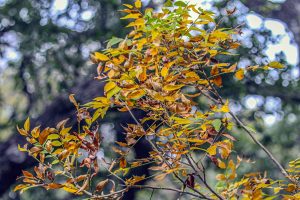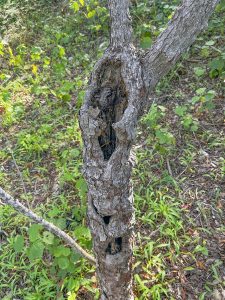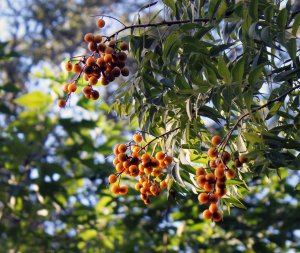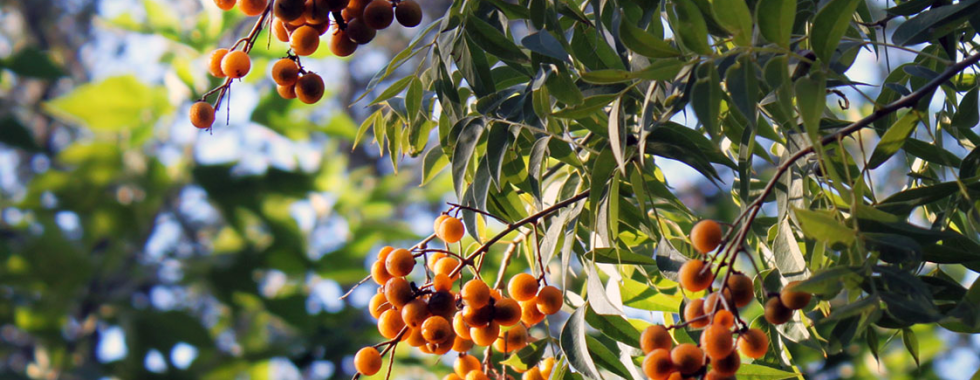Trail Notes: The Remarkable Soapberry Tree
 The first time I saw it, I thought, “Now there’s an odd-looking pecan tree.” The compound leaves were long and pointed in the manner of pecans, but they were smaller, and the tree didn’t look quite right. Unlike the pecan, which can reach 70-100 feet, the soapberry typically grows to only 40-50 feet in height. The current National Champion, measuring 61 feet tall and 9 feet in circumference, can be found in Texas’ Aransas County.
The first time I saw it, I thought, “Now there’s an odd-looking pecan tree.” The compound leaves were long and pointed in the manner of pecans, but they were smaller, and the tree didn’t look quite right. Unlike the pecan, which can reach 70-100 feet, the soapberry typically grows to only 40-50 feet in height. The current National Champion, measuring 61 feet tall and 9 feet in circumference, can be found in Texas’ Aransas County.
 My own experience with the soapberry tree, sometimes called “wild chinaberry” because of its unfortunate resemblance to that invasive species, has been primarily in my own backyard. Two relatively old trees—“old” in this case being a little more than 20 years—stand on either side of the path leading to the dog run, compost bins, and vegetable patch. One of them is probably 25 feet in height, while the other is more like 20. “I’m amazed that one’s still alive,” my husband said of the shorter tree when he noticed the way two of its main branches were growing out of what looked to be a dead and hollow trunk. Amazing indeed, I thought, remembering its apparent death and rebirth a number of years ago.
My own experience with the soapberry tree, sometimes called “wild chinaberry” because of its unfortunate resemblance to that invasive species, has been primarily in my own backyard. Two relatively old trees—“old” in this case being a little more than 20 years—stand on either side of the path leading to the dog run, compost bins, and vegetable patch. One of them is probably 25 feet in height, while the other is more like 20. “I’m amazed that one’s still alive,” my husband said of the shorter tree when he noticed the way two of its main branches were growing out of what looked to be a dead and hollow trunk. Amazing indeed, I thought, remembering its apparent death and rebirth a number of years ago.
The western soapberry (Sapindus Saponaria, or “soapy soap”) is definitely one tough tree. It easily survives heat and drought, as well as cold down to about 5 degrees. But because of its tendency to create thickets by sending out suckers, some consider the soapberry an invasive weed. I take issue with that. To me, the soapberry is simply a survivor—and a beautiful one at that.
Most autumns—at least those that begin with leaves still on the trees and after a good cold snap or two—soapberries can be counted on to turn a brilliant gold, somewhat like the Mexican buckeye. At about that time, the berries that appeared over the summer also begin to transform from tiny golden grape-like fruits to translucent amber globes. I first noticed them this fall as they started dropping from the trees.
Though these fruits are poisonous, birds love them, another fact that accounts for the tree’s wide distribution. Similarly, native bees and butterflies are attracted to the dense clumps of creamy white flowers in the spring and early summer, and the soapberry hairstreak in particular uses the tree as a larval host.
 What is probably most curious about the soapberry tree, however, is the property that gives it its name: The berries’ use as soap. As Matt Warnock Turner explains in Remarkable Plants of Texas: Uncommon Accounts of Our Common Natives, “The waxy berries contain up to 37% saponins, which are surfactants (surface-active agents) that reduce surface tension and foam when shaken, as in the case of soap. Mash the fruits in water to produce a good lather, or simply rub one fruit with a little water over the hands for an instant soap (water is essential, or you’ll have a sticky mess).” Turner’s method works, and while he found the results pleasant, some people do complain of itching afterward. My own experience using the “soap” was singularly unmemorable.
What is probably most curious about the soapberry tree, however, is the property that gives it its name: The berries’ use as soap. As Matt Warnock Turner explains in Remarkable Plants of Texas: Uncommon Accounts of Our Common Natives, “The waxy berries contain up to 37% saponins, which are surfactants (surface-active agents) that reduce surface tension and foam when shaken, as in the case of soap. Mash the fruits in water to produce a good lather, or simply rub one fruit with a little water over the hands for an instant soap (water is essential, or you’ll have a sticky mess).” Turner’s method works, and while he found the results pleasant, some people do complain of itching afterward. My own experience using the “soap” was singularly unmemorable.
Historically, the soapberry has had a variety of uses. Turner notes that the Kiowa “made cuts in the stems in order to gather the latex, which they used as a healing agent for wounds.” Ironically, as the late botanist Barton Warnock pointed out, leaves of this poisonous tree were used in some cases to relieve indigestion. The round black seeds made good substitutes for beads and buttons, and the wood, which Turner observes is given to splitting into “thin, pliant strips,” was made into stakes, baskets, and frames for saddles. Finally, says Turner, the pulp of the fruit itself can be used to make floor wax and varnish, as well as yellow dye.
I haven’t decided what to do with them yet, but I currently have a tray of soapberries sitting on my front porch to dry. In How to Grow Native Plants of Texas and the Southwest, Jill Nokes describes several methods of separating the fruits’ seeds from the pulp. All of them sound tedious to me. One requires soaking the seeds in water containing just a touch of lye, a process that may involve “several rinsing and soakings.” Given that I have no lye sitting around the house, I’ll probably go with Option 2—putting the fruit in a blender with a little water, and then, after the machine has done its work, rinsing the seeds over a screen. The next step is to scarify the seeds, something that can be done using sulfuric acid or, if that sounds as unappealing to you as it does to me, soaking them in hot water for a day or so. Either way, most sources recommend stratification next. This can be done by keeping potted seeds in a moist, cool place, or by placing the seeds between moist paper towels and putting them in the fridge to replicate winter dormancy. Again, Option 2 sounds more reliable to me, given how warm our winters can sometimes be.
Regardless of how I proceed, I’m looking forward to having a few more soapberries this coming spring.
Written by Susan Hanson, editor of The Loop.


